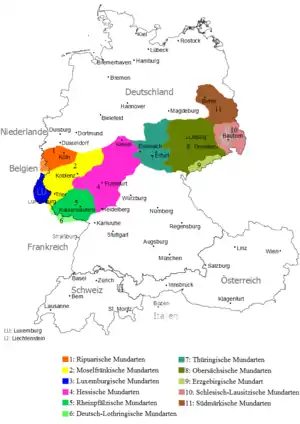Central German
Central German (German: mitteldeutsche Dialekte, mitteldeutsche Mundarten, Mitteldeutsch) is a group of High German dialects spoken from the Rhineland in the west to the former eastern territories of Germany.
| Central German | |
|---|---|
| Mitteldeutsch | |
| Geographic distribution | Western and Central Germany, southeastern Netherlands, eastern Belgium, Luxembourg and northeastern France |
| Linguistic classification | Indo-European
|
| Subdivisions | |
| Glottolog | fran1268 |
 Central German dialects
| |
Central German divides into two subgroups, West Central German and East Central German.
Central German is distinguished by having experienced the High German consonant shift to a lesser degree than Upper German. It is spoken in the linguistic transition region separated from Northern Germany (Low German/Low Franconian) by the Benrath line isogloss. It is separated from Southern Germany (Upper German) by the Speyer line.
Central German is spoken in large and influential German cities like the capital Berlin, the former West German capital Bonn, Cologne, Düsseldorf and the main German financial center Frankfurt.
The area corresponds to the geological region of the hilly Central Uplands that stretches from the North German plain to the South German Scarplands, covering the states of Saarland, Rhineland-Palatinate, Hesse, Thuringia and Saxony.
The East Central dialects are the closest to Standard German (chiefly as a written language) among other German dialects. This is due to the fact that the text in Martin Luther's Bible and the language used by Electorate of Saxony state officials, developments that influenced the standardization of German, contained features which aligned closest to the language spoken between the area of Erfurt and Dresden. Modern Standard German thus evolved from the vocabulary and spelling of this region, with some pronunciation features from East Franconian German.[1]
Classification
- West Central German (Westmitteldeutsch), part of the Franconian language group
- Central Franconian (Mittelfränkisch)
- Ripuarian (Ripuarisch)
- Moselle Franconian (Moselfränkisch)
- Luxembourgish (Luxemburgisch), also considered a Moselle Franconian variant
- Lorraine Franconian (Lothringisch), also considered a Moselle Franconian variant or general term for all Franconian dialects spoken in French Lorraine (francique lorrain)
- Rhine Franconian (Rheinfränkisch)
- Palatinate German (Pfälzisch)
- North Hessian (Nordhessisch)
- East Hessian (Osthessisch)
- Central Hessian (Mittelhessisch)
- South Hessian (Südhessisch)
- Central Franconian (Mittelfränkisch)
- East Central German (Ostmitteldeutsch)
- Thuringian (Thüringisch)
- Upper Saxon (Obersächsisch)
- Erzgebirgisch
- North Upper Saxon (Nordobersächsisch)
- Lausitzisch-neumärkisch,[2] also Sorbian language area
- East Central German dialects spoken in the former eastern territories:
- Silesian (Schlesisch), nearly extinct
- High Prussian (Hochpreußisch), nearly extinct
See also
Notes
- Besch, Werner; Wolf, Norbert Richard (2009). Geschichte der deutschen Sprache. Berlin: Erich Schmidt. p. 227. ISBN 9783503098668.CS1 maint: ref=harv (link)
- Ludwig Erich Schmitt (editor): Germanische Dialektologie). Franz Steiner, Wiesbaden 1968, p. 143
